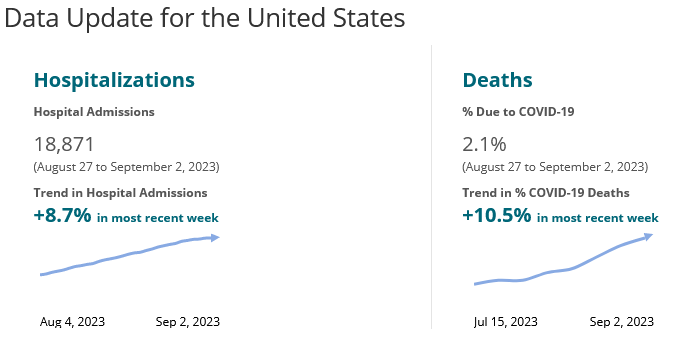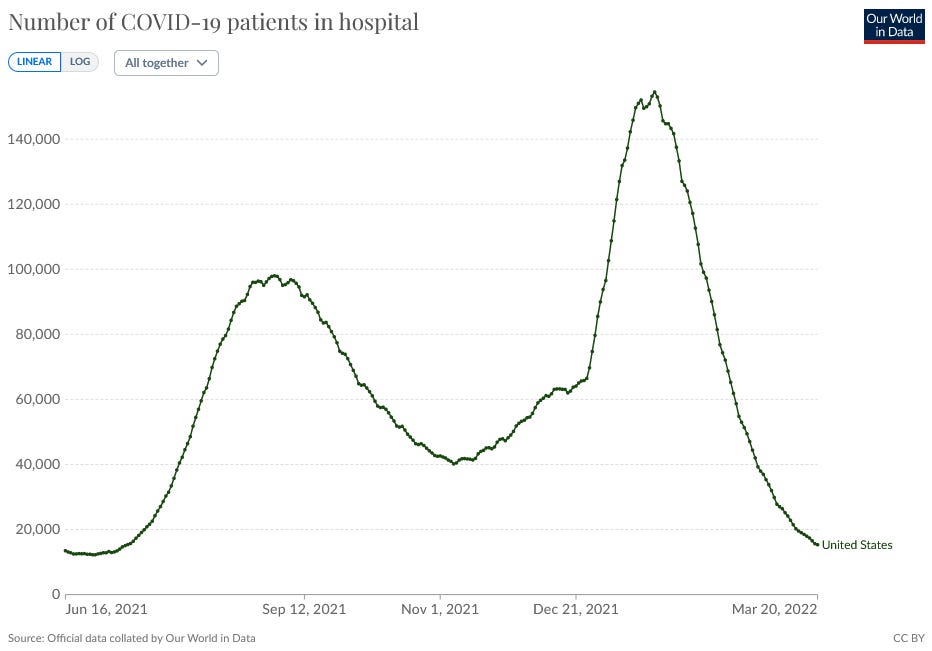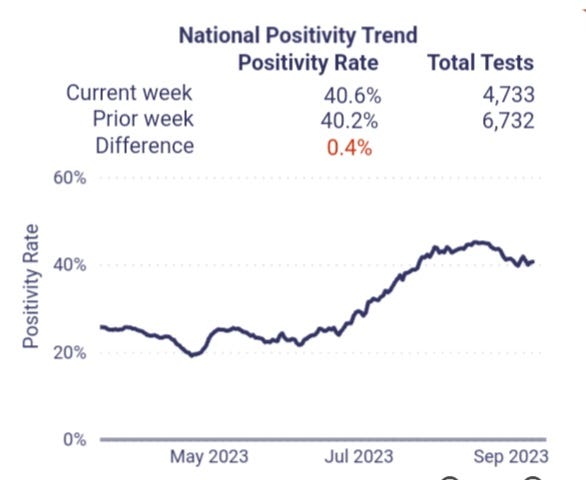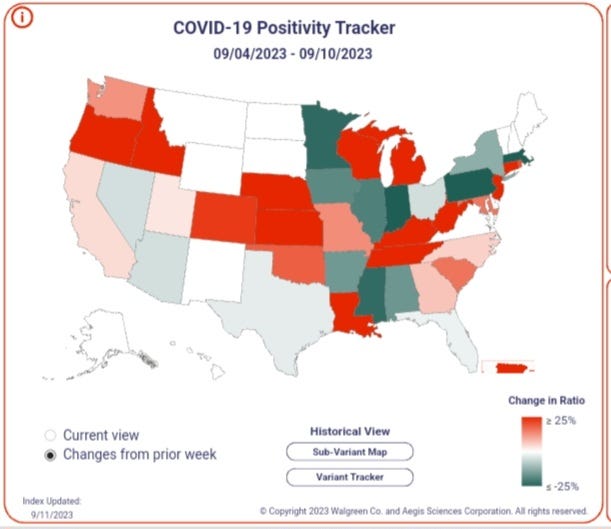COVID Update: Sept 14 2023- Could COVID Become a Life Long Chronic Disease Like EBV or HIV? We might be closer than you think.
The Current Situation, Forecast and COVID Evolution
We are in a situation that we have multiple highly evolved variants gaining ground and that gives COVID the evolutionary advantage. The greater the variety of variants that are spreading, and in many cases persisting in viral reservoirs throughout the body and brain, the greater the odds COVID has of continuing to thrive and out maneuver the vaccines and treatments. The variants that are most prevalent are all highly immune evasive and suppressive, capable of infecting almost every type of immune cell and even the thymus. Being able to infect the thymus can potentially have much earlier quality of life impacts and ultimately shorter lives. We are talking about causing autoimmune disorders, and other older age issues ten or more years earlier than they otherwise would occur. This could be particularly dangerous for younger children. See the “COVID May Be Causing Irreversible Damage to Children’s Immune Systems” for more information.
We'll examine signals indicating transmission slowdown in some areas while its rise continues in others. Unfortunately, without mitigation, numerous highly immune-evasive and suppressive variants are gaining traction. Our primary focus is on the notably evolved BA.2.86 and its sub-variants, as they seem increasingly likely to trigger a substantial surge from Fall through January. This surge could potentially surpass the 2021/2022 peak, with several factors contributing to it becoming more persistent in the human body than earlier variants.
First let’s look at the increasing hospitalizations and deaths in the U.S. The CDC is reporting an 8.7% increase in hospitalizations and a 10.5% increase in deaths from August 27th through September 2nd 2023. The increase is slowing down compared to 15% increase in hospitalizations for the prior period.
Hospitalizations may start declining nationally, within the next two reporting periods, based on data we will look at shortly. The trend is following very closely to how things went in 2021. Hospitalizations peaked during the first week of September. They declined until November 7th, then they started increasing until January 19th, 2021.
There is a good chance we will follow a similar trend to 2021. The latest booster is unlikely to prevent infection of the latest variants for very long, particularly in environments where the viral load is permitted to build up in a space like classrooms. The higher the viral load, or the more virus entering the body, the harder it is for the body to defend against and the more likely the virus will be able to persist. The data to date on the new boosters does not show how long the neutralizing antibodies last but we can look back on prior data and know that they are unlikely to last for more than one to three months.
We discussed in the Sept 8th post, that we could predict that Japan hospitalizations would stop increasing and start declining in the last week of August, just like it has for the prior three years. This is what has happened, with the peak in hospitalizations occurring in the last week of August.
Why is it so consistent?
“Schools close in Japan around July 20th for summer break. It isn't a coincidence that hospitalizations peak 2 to 4 weeks later. Schools closing stopped the exponential growth between classrooms and homes, students to siblings, and then to new classrooms. Along the way spreading to parents, coworkers, and up through the age groups.”
Now, “lets consider what the new mutated BA.2.86 that ripped through the care home in the U.K. What will an 86% SAR (Secondary Attack Rate) mean for schools once this variant takes old in schools. It means that a peak of exponential growth in January has the potential to match or surpass the first Omicron surge.” BA.2.86 is expanding, being sequenced in more countries around the world. BA.2.86 has been sequenced in at least 13 countries and 7 U.S. States.
COVID Evolution
Becoming milder isn't guaranteed. There are paths for it to become more virulent causing more severe symptoms or to become more persistent, causing chronic, long-term health issues.
COVID'S evolution was reviewed in a study published in April 2023. The following section quotes are from this study. COVID has been headed towards immune evasion and suppression in order to get to areas of the body that the immune system can't easily remove it. This allows it to persist in viral reservoirs throughout the body and brain. This enables it to survive for longer periods and wait for another variant to infect the body. When a person is infected with two variants they can recombine into a new more evolved variant. This helps ensure the survivability of the virus. Other viruses persist in people for life, like EBV, HIV, and the varicella virus. The varicella virus causes chicken pox and then shingles later in life or when the immune system is weakened.
”Immunological dysfunction persists for 8 months following initial mild-to-moderate SARS-CoV-2 infection”, published in Jan. 2022 said, “A comparable reduction in B cells and a more severe reduction in the total amount of T cells in COVID as compared to AIDS. The total numbers of T cells, in particular of the CD8+ subpopulation, are lower in COVID than with AIDS, while the CD4+ are reduced in both.” This gives the virus time to get into places the immune system can’t easily remove it.
"SARS-CoV-2 tends to cause severe disease or death late, towards the third week post infection, whereas the infectious period usually spans from day 2 to day 15, with 90% of transmission already achieved before the average time of death. As long as a viral lineage successfully carries on transmitting further to multiple other hosts, the ultimate fate of the initial host will not substantially impact its fitness. In this situation, high virulence is not a fitness impediment for the virus and would not be selected against."
"Increasing virulence can be a by-product of viral evolution, where the virus evolves to maximize other traits that increase its fitness, but that are linked to virulence. An example of this situation is SARS-CoV-2 viral loads. Increased viral abundance contributes to better chances of transmission — a crucial fitness trait for the virus. Yet higher loads may also result in more severe disease. In such a situation, a virus may evolve higher virulence, if there is a net gain in fitness."
"An additional important and underappreciated point related to virulence is that highly transmissible pathogens (whether due to high intrinsic transmissibility or immune escape) with lower infection fatality ratios can contribute to high population-level disease burdens, overshadowing in that respect extremely pathogenic but less transmissible pathogens (Fig. 4c). Examples of this are MERS-CoV and SARS-CoV, where the former, despite a staggering infection fatality ratio of more than 30% has, due to its relatively low transmissibility, caused a total of 935 deaths since 2012 (ref. 124). By contrast, SARS-CoV-2, with an estimated infection fatality rate well under 1%, has as of today killed more than 18 million people."
"Overall, given the current evidence in support of chronic infections generating immune-evading mutations, it is reasonable to assume that such infections are likely responsible for the emergence of at least some of the VOCs. This suggests that finding and treating individuals who are chronically infected must be a high public health priority."
Unfortunately, we are failing to identify and treat chronically infected individuals, even though some significant evolutionary leaps happen in those with persistent infections. It's crucial to protect those in immunocompromised states or dealing with other illnesses or injuries, as their bodies are already fighting to recover. This issue persists as healthcare settings underestimate the significance of airborne transmission.
Uncontrolled transmission in hospitals and schools ensures more individuals will develop chronic infections, akin to fueling a fire. Abundant evidence highlights that even asymptomatic or mildly symptomatic infections can result in long-term health issues, including heightened risks of heart attacks, strokes, cognitive and neurological problems, musculoskeletal dysfunction, and over 200 Long-COVID symptoms. It's imperative to contemplate the lasting human effects of unchecked transmission and the unintended advantage we are affording the virus.
Could COVID become a life long chronic disease like EBV or HIV? We might be closer than you think.
COVID & AIDS are listed as the leading cause of lymphocytopenia. This increases recurrent viral, bacterial or fungal infections and also increases the odds of cancers and autoimmune disorders.
On Sept. 10th, Shan-Lu Liu, a prominent virologist and researcher, known for his work in the field of virology, posted to Twitter/X the following. "We find that BA.2.86 has low infectivity in 293T-ACE2 cells, similar to @yunlong_cao results, but high infectivity in CaLu-3 cells - actually the highest among all Omicron variants tested"
After reading this post, I had some questions so I asked GPT 3.5 for some answers and the answers take us to a place we really don’t want to be. Follow along with this conversation and if it is confirmed to be true, could explain the high attack rate found in the U.K. and could be predictive of a variant much more likely to cause persistent infections.
(The following is a conversation with GPT-3.5 to find some answers to Shan-Lu Liu’s post on X, formerly Twitter)
What cell types are similar to CaLu-3 cells in the human body?
"Calu-3 cells have characteristics similar to serous nasal cells"
" However, they are not originally from nasal epithelium but rather from human lung adenocarcinoma"
"Calu-3 cells are grown at an air-liquid interface and demonstrate many characteristics of the bronchiolar epithelium, which, in vivo, serves as the barrier layer between inspired gas and other visceral tissues. This attribute is particularly advantageous for the evaluation of airway injury and response to medical treatments and respiratory therapeutic interventions."
Reference provided: https://www.ncbi.nlm.nih.gov/pmc/articles/PMC2951077/
What are serous cells?
"Serous cells are one of the two predominant epithelial cell types of mammalian airway glands."
"They are found in the respiratory epithelium lining the proximal septum and the nasopharynx"
"Serous cells contain small electron-dense granules and secrete a wide array of antimicrobials."
Ok so its possible that it is highly infective of serous cells. I asked,
What if a new SARS-CoV-2 variant was found to be highly infective of serous cells?
"If a new SARS-CoV-2 variant was found to be highly infective of serous cells, it could potentially have implications for the spread and severity of COVID-19."
Then I asked,
There is evidence that a new variant is highly infective of CaLu-3 cells, which have characteristics of Serous cells. If SARS-CoV-2 is using serous cells could it be using transcytosis like EBV and HIV and crossing the epithelial barrier?
”Transcytosis is a process by which a molecule or particle is transported across an epithelial barrier by endocytosis on one side of the barrier and exocytosis on the other side”
"If a new SARS-CoV-2 variant was found to be highly infective of CaLu-3 cells, which have characteristics of serous cells, it could potentially have implications for the spread and severity of COVID-19."
"If SARS-CoV-2 were to use serous cells, it could potentially use transcytosis to cross the epithelial barrier, similar to how Epstein-Barr virus (EBV) and human immunodeficiency virus (HIV) enter the host cell."
Reference provided: https://www.nature.com/articles/s41392-021-00719-9
In other words, hypothetically, BA.2.86 could end up causing more persistent infections leading to chronic disease. This is resembling airborne AIDS.
Again, important to note that's if it's found to be highly infective of serous cells which as of now, only the CaLu-3 cells have been confirmed.
Lets take a look at the various signals showing a temporary decline in prevalence.
Google Trends - Search term: COVID symptoms
We can see that less people are doing google searches for COVID symptoms and this is similar to the other data we will look at.
Walgreens positivity tracker shows that we are off the peak however this does show a leveling off nationally and when we look at the next pic provided by Walgreens data tracker, we can see that many states are still seeing an increasing positivity rate.
Walgreens testing data shows that many states are still seeing an increasing positivity rate, shown in the shades of red.
Biobot COVID wasterwater tracking is showing a similar situation with a slowing of increasing prevalence in the NorthEast (yellow), a slight decline in the
Biobot COVID wastewater data also provides a year over year view and we can see below, that the 2023 (yellowish green) wastewater prevalence is following a similar trajectory to 2021 ( light blue).
The question is, will these new variants wreak havoc on our long term health and just how transmissible will they be? Based on the preliminary data, we should be following the precautionary principle and utilizing every tool to limit transmission in schools and hospitals.
The media and public health officials may want us to believe that COVID is no longer a risk to our health and safety, but they are ignoring the vast number of risks associated with each new infection. Furthermore, they are overlooking the millions of people who already suffer from persistent infections and the horrible, often debilitating symptoms associated with Long COVID. This is a rapidly evolving situation, and media coverage has nearly vanished. Therefore, independent sources that keep up-to-date with the latest science and data are more important than ever.
If you want to stay informed and support this vital work, please consider becoming a paid subscriber or donating a subscription.













